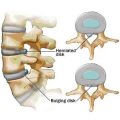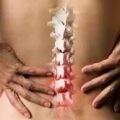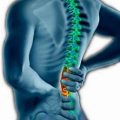Symptoms of bulging disc occur when a spinal disc bulges and swells on its weak point; compressing the nearby nerve roots on spinal cord. The pressure causes the pain receptors to send signals throughout the compressed nerve while simultaneously disrupting the sensory information transmission, causing numbness, pain; and tingling sensation throughout the body. Also, pressure on spinal curve also causes weakness of arm or leg muscles, depending which way the affected nerve goes. In some cases, bulging disc don’t compress any spinal nerves, which results to no painful symptoms.
The Three Origins of Bulging Discs
Bulging disc, along with its symptoms; can come from any of 3 regions of the spine that categorizes the intervertebral discs. Pain, numbness and tingling sensation are all common in any region; but there are some details where the origin and resulting symptoms differ.
For Cervical Bulging Disc
The cervical region refers to the neck, which is at the C1 to C7 vertebrates. There are however, no spinal disc between C1 and C2, which is also referred as atlas and axis, respectively.
Compression on the nerve root results to symptoms on the neck region include pain, numbness, tingling; and weakness on the neck that goes all the way down to the shoulders, arms and fingertips. Nerve compression on the cervical region can also develop into myelopathy; which is a collection of different painful symptoms that includes difficulty in easy daily functions, such as walking, loss of motor skills on fingers; and legs feeling heavy.
For Thoracic Bulging Disc
The upper and middle back (thoracic region) includes to the 12 vertebrates of the spine named T1 to T12; which starts in the collar bone all the way down to the last segment of the rib. Though thoracic region bulging disc is less common; they can cause pain that originates around the upper back and can radiate all the way to the front; particularly the chest and stomach. This very nature of the symptom misleads people to believing that they experience heart, lung, or gastric tract problems. Thus, it is crucial to consult your doctor to get the right diagnosis.
For Lumbar Bulging Disc
The lumbar area refers to lower back, which are the 5 (or sometimes 6) vertebrates called L1 to L5 (L6). Spinal disc problem in this region is the most common cause of low back pain problems. Symptoms include burning, dull and sharp pain that radiates all the way to the backsides; legs and down to the feet. Also, spinal disc problems on this region of the spine result into tingling sensation and numbness, weakness, and muscle spasms. In many cases, symptoms may worsen even when just sneezing, coughing and bending over.
If the bulging disc on the lumbar area results to painful symptoms, doctors often refer to it as sciatica. In some rare cases, people with this condition experience loss of bowel or bladder control as symptoms. If this is the case, then it is crucial for patients to see their doctor as soon as possible, as it may be a sign of cauda equina syndrome (CES), which affects a bundle of nerve roots, a special condition that most definitely needs surgery.






 I love to write medical education books. My books are written for everyone in an easy to read and understandable style.
I love to write medical education books. My books are written for everyone in an easy to read and understandable style.